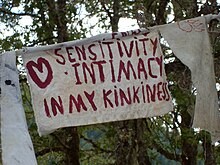User:Blurpeace/Nomenus
Nomenus is a Radical Faerie commune located in southern Oregon at the Nomenus Wolf Creek Sanctuary. The Sanctuary is one among a number located around the United States and abroad.
[edit]
Boag situates the history in terms of the gay rights movement backdrop in American history. He sees their development as a result of disenchantment on the parts of gay men and lesbians with liberation movements at the close of the 1970s. Under this view, the Nomenus camp should be seen in terms of the other progressive communes forming in southern Oregon around the same time, such as the Oregon Women's Land Trust and Fly Away Home. He also employs the term "back-to-the-land" to describe these groups' ideology.[1]
Radical Faerie movement[edit]

[edit]
The Nomenus site is principally located at the Nomenus Wolf Creek Sanctuary in the small town of Wolf Creek in southern Oregon, just 50 miles northeast of Medford. The Sanctuary is about 80 acres large and is a settled rectangular meadow. The Sanctuary is bordered by the eponymous Wolf Creek river in the near east, and the other three cardinal directions beyond the site's borders are uncultivated forest.[2] The entrance to the site is demarcated by a sign made from "tall thin poles decorated with colorful fabrics, between which [hangs] a string of letters woven from twigs that announce[s] 'WELCOME HOME'".[3]
In the late 1970s, Magdalen Farm was the original name for the present-day site; the name Creekland was to follow, when the site was still in use by what Morgensen calls "back-to-the-land" collectives, a play on and catch-all term for the settler-indigenous dichotomy he introduces to explain Radical Faerie beliefs.[4] The Creekland community was in ownership of the site until 1986, when a gathering at the site resulted in a changing of hands to the now-Nomenus Wolf Creek Sanctuary. Nomenus was founded by urban gay men in San Francisco in 1984 and was tasked with acquiring land for the group in order to end their then-itinerant practices. In short, the group was searching for a site to call their own, and they found that in Wolf Creek.
The beliefs of the two groups that preceded Nomenus's ownership were in the same vein and the histories of those groups were folded into the Sanctuary's understanding of its own.[4] Magdalen Farm, for instance, was "formed by adopting Maoist principles and linking collectivist gay men in rural gathering, including the 1976 'Faggots and Class Struggle' conference."[5] The beliefs of the Radical Faeries, and thereby those of Nomenus, both in large part a product of gay activist Harry Hay's charismatic influence, are not a far departure from those groups that preceded it, consummations of the height of the American sexual revolution.[6]
The handful of buildings on the site border the Sanctuary, in large part the Garden House and the Barn. The Garden House is the Sanctuary's common quarters and houses the Sanctuary's library. The Barn is where the Sanctuary stores its food stock and cooks its meals; it acts as a kitchen for the site. The Garden House library is primarily composed of texts left behind by residents and visitors, including the gay magazine publication RFD. Morgensen argues that the library acts as a "legac[y]" for the Sanctuary and provides a sense of continuity for returning individuals to the site.[2][4]
Morgensen argues that the "WELCOME HOME" arch at the entrance to the Wolf Creek site should be understood as meshed in the cognitive content of the Radical Faeries. The arch simultaneously welcomes one onto the site as a newcomer but also into what Morgensen calls the Radical Faerie belief that one comes into realization of an "authentic [gay] subjectivity".[7]
Footnotes[edit]
- ^ Boag, "Gay and lesbian rights movement," The Oregon Encyclopedia, http://www.oregonencyclopedia.org/articles/gay_lesbian_rights_movement/.
- ^ a b Morgensen, "Arrival at Home," 73.
- ^ Morgensen, "Arrival at Home," 67.
- ^ a b c Morgensen, "Arrival at Home," 74.
- ^ Morgensen, "Arrival at Home," 76.
- ^ Morgensen, "Arrival at Home," 76-78.
- ^ Morgensen, "Arrival at Home," 70.
Bibliography[edit]
- Boag, Paul. The Oregon Encyclopedia, s.v. "Gay and lebsian rights movement." Oregon: Oregon Historical Society. http://www.oregonencyclopedia.org/articles/gay_lesbian_rights_movement/ (accessed June 25, 2014).
- Scott Lauria Morgensen. "Arrival at Home: Radical Faerie Configurations of Sexuality and Place." GLQ: A Journal of Lesbian and Gay Studies 15, no. 1 (2009): 67-96. http://muse.jhu.edu/ (accessed June 25, 2014).
- Morgensen, Scott. "Back and Forth to the Land: Negotiating Rural and Urban Sexuality Among the Radical Faeries". In Out in Public: Reinventing Lesbian/Gay Anthropology in a Globalizing World, edited by Ellen Lewin and William L. Leap, 143-163. Wiley-Blackwell, 2009.
